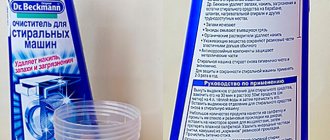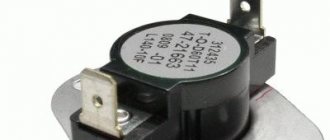A few years ago, preparing basic dishes required a lot of housewives’ time and effort. The appearance in household appliance stores of a kitchen appliance that can cook, fry, stew, bake, heat and maintain the temperature of a ready-made dish practically without human control could not go unnoticed.
And the name spoke for itself: “multi-cooker.”
A skeptical attitude quickly gave way to trust in the new device, and soon an irreplaceable assistant appeared in many apartments, significantly simplifying the procedure for preparing dishes, regardless of their degree of complexity.
On top of that, the miracle device turned out to be easy to use and affordable.
If not for one BUT. And this BUT is an unpleasant odor that could manifest itself not only after preparing a fragrant dish, but was also sharply revealed in a completely new, just purchased, appliance.
Where does the stench come from?
Let's try to figure out where the unpleasant smell in the multicooker comes from. For new devices that have not yet worked, the reason may be the use of low-quality materials in the manufacture of the device, as well as non-compliance with the temperature conditions during transportation and storage.
The manufacturer itself does not consider the smell in the new device to be a disadvantage and usually offers ways to combat it in the instructions.
At the same time, neither the brand, nor especially the price, can serve as a guarantee of the absence of odor.
The only sure way to avoid an unpleasant surprise is to smell the multicookers that match the characteristics and price right in the store, without paying attention to the sellers and other buyers, and choose the only one, your own, without the smell of rubber and mustiness.
The appearance of a smell after cooking does not frighten you, especially since cleaning the non-stick bowl, lid, silicone seal and valve takes very little time. But sometimes regular washing is not enough, the smell remains. We have to look for radical measures to combat it, we will talk about this a little later.
Another reason why a foreign aroma may persist is insufficient care of the multicooker..
Having washed all the above parts, the housewife forgets about the plastic container for collecting excess fat and condensation, which is located on the back of the multicooker, and it reminds of itself as much as possible. Or, after washing the silicone seal, he does not wipe it dry.
Or he dries the bowl by turning it over and placing it on a flat table surface. But you never know what we might miss in the hustle and bustle of modern life! Therefore, let’s call our mistakes “insufficient care” and move on.
The smell can also arise from improper installation and improper storage of the multicooker in the kitchen.
This usually happens if the device is in a closed cabinet, not far from heating radiators, in direct sunlight, or is simply stored with the lid tightly closed.
And finally, the smell is inevitable if you keep cooked food in a slow cooker for a long time, repeatedly heating it . No comments here: the aroma of food will permeate the silicone seal, and it will take some time to get rid of it.
Why does the multicooker smell?
Conventionally, two reasons for the appearance of odor can be identified: improper maintenance of the device and manufacturer defects. The aroma of burnt rubber or plastic can also appear in new technically sound devices. In this case, you don’t need to do anything - after 2-3 days after purchase or several cooking cycles, the unpleasant smell will disappear on its own.
If you bought a cheap multicooker, the reason for the foreign odors will be the poor quality of the material. When heated, inexpensive types of plastic release substances that are the culprit of the problem. In this case, no means will help; it is better to take the multicooker to the store and ask for your money back.
At first there were no complaints, but after a certain time an unpleasant odor appeared - the reason was the proliferation of bacteria. They become the culprits, so the fight should have an antimicrobial focus.
The smell may come from:
- cover O-ring;
- glasses for collecting condensate;
- safety valve or its seal.
Less often, the bowl itself “smells” - after cooking fish or when it is poorly washed. Heating elements in a working multicooker do not emit any odor.
How to eliminate the stench in a new appliance?
A new multicooker, just like any new electrical appliance, when first used, in most cases has a foreign plastic smell.
- Firstly, the technical lubricant burns out.
- Secondly, the bowl itself, the seal, the valve, and other materials from which it is made smell.
This is a natural process, which in a quality item will not cause any trouble to the owner - the grease will burn naturally, and the multicooker itself, after washing with warm water and detergent and subsequent rinsing, will no longer smell like plastic and who knows what.
But this is ideal, but in practice it happens that the foreign smell is not eliminated even after the second and third wash, spoils the taste of the prepared food and makes you think about returning the purchase . True, a return is not always possible, so I suggest that you first enter into an unequal battle with an unpleasant smell and see what comes of it. Moreover, there are plenty of ways to eliminate it.
We repeatedly wash our assistant, paying special attention to the silicone seal and valve, using a soft rag or paper towel to carefully wipe other parts and the body from the inside, drying the bowl and valve separately. Store the assembled multicooker in a cool place, making sure it is not exposed to sunlight.
Do not close the lid tightly. We leave substances that absorb odors in it. Does not help? We boil water in it with the addition of various means.
How to care for a household appliance so that it does not develop an unpleasant odor?
All these procedures will not be useful if you take care of the miracle saucepan on time and correctly.
Processing and storage features of the multicooker:
- There is no need to keep cooked food in a bowl; it is better to transfer the dish to another container after cooking.
- Periodically soak the bowl and valve with seal in soapy water for 15 minutes. Wash with a soft sponge. Afterwards, be sure to rinse and wipe with a dry towel.
- Open the lid when storing. A tightly closed pan will become saturated with a stale smell and will have to be washed again.
- It is better to keep the cabinet doors slightly open, this way you can avoid additional treatment with a cleaning agent.
- After cooking and cleaning the pan, you need to add a slice of ripe lemon and a little peel to the water and turn on the boiling mode.
- If odors appear periodically, you should leave a saucer with coarsely chopped lemon in a clean saucepan.
Such measures will not leave a trace of the previous smell of mustiness, spoiled food or plastic. In addition to standard methods using chemicals, to get rid of unpleasant odors, there are many cleaning options using improvised substances that can be found in every kitchen. These measures are popular among the people and time-tested. If you apply the listed processing methods and follow the storage rules, you can constantly cook tasty and healthy food in a smart saucepan without much effort on the part of the housewife.
Nowadays, not a single housewife can imagine her kitchen without such a unique device as a multicooker. With such a compact and incredibly functional kitchen “device” you can greatly simplify the process of preparing tasty and healthy food. The modern assistant has one significant drawback, which is the specific smell that is present in new devices. In this article we will try to figure out how to remove the smell from the Redmond multicooker.
How to clean after cooked foods?
It is necessary to care for the multicooker after each use..
Wash, dry, do not be lazy to disassemble the valve and wipe the non-removable parts dry. And don’t forget - any disaster is easier to prevent. Therefore, you should think carefully about whether you should cook strong and persistently smelling foods in a slow cooker, or take your favorite saucepan to cook fish soup.
If the multicooker is used quite actively, you need to purchase another bowl, as well as professional cleaning products (Bright MultiCare, Top House).
Do you trust folk recipes?
Not really
How to clean the lid from frozen fat?
There are two types of multicooker lids:
- removable;
- built-in
There will be no problems with the first type. To clean such a lid, you just need to wash it using anti-grease products and a soft sponge, and then rinse with running water.
Owners of a multicooker with a non-removable lid are out of luck. They will need to do the following:
- Wrap the multicooker in cellophane, leaving the lid on the outside.
- Tilt the equipment.
- Wash the lid as you would a regular removable one.
- Wipe dry with a cloth.
- Do not use equipment for 1-2 days.
Often the inside of the lid becomes quite dirty - grease and food particles remain on it. You can clean it in a safe way:
- Pour a small amount of water into the multicooker.
- Put a piece of lemon in it.
- Turn on “Steam” and leave for 10-15 minutes.
- Drain the water and wipe the device.
Cleaning products
All of the following means and methods are suitable for eliminating odors in both a new and working multicooker. The only thing you need to pay attention to is the concentration of the solutions used .
Although multicooker parts are designed to withstand high temperatures and long-term use, it is unlikely that a high concentration of, for example, vinegar essence will benefit them.
Lemon
This method is recommended by the manufacturer and is outlined in the instructions for many models of multicookers.
- Pour about one-third of the water into the bowl.
- Add chopped lemon or a little citric acid there.
- Turn on the “steam” mode for 15-20 minutes.
- Without opening the lid, wait until the water cools down and repeat heating.
- Again we wait until the water becomes warm, after which we wash the bowl, the multicooker lid, the silicone seal and the removable valve with the same water.
- Then rinse with clean water, gently wipe with a soft rag or paper towel and leave the multicooker with the lid open until completely dry.
There is another, more labor-intensive way to eliminate odor using lemon. To do this, you need to cut the lemon and thoroughly wipe all surfaces of the multicooker with half, except the heating elements .
Citric acid can also help in cleaning the microwave from carbon deposits and grease.
Vinegar
Vinegar is a universal folk remedy for eliminating any odors. Works great. We wash all the parts of the multicooker with a weak solution of vinegar or acetic acid in warm water. Make sure that the sponge or rag is soft and does not scratch the surface . Next, as usual, rinse, wipe, and dry.
Most likely, after washing, a faint smell of vinegar will remain, but it will dissipate within a few hours.
You can read about how to use vinegar to clean the grease inside an electric oven here.
Coffee
Another universal odor absorber. It’s not for nothing that its grains can be found in perfume departments of stores, where they successfully combat mixed odors of cosmetics.
You shouldn’t expect an immediate effect from using coffee, but if you pour a few beans onto a plate and place it in the multicooker bowl overnight, the smell from the previously prepared dish will disappear without a trace.
Welding
You can try to eliminate the unpleasant odor using tea leaves . To do this, after preparing food, the multicooker bowl needs to be rinsed and then treated with dried tea leaves.
This method has its pitfalls: firstly, the bowl may change its color due to interaction with the tea leaves, and, secondly, grains of tea may fall to the bottom of the multicooker body, and removing them from there will be inconvenient.
Salt or soda
They can be used separately or together. But in the case of a multicooker, a soda solution is more versatile, suitable for both washing the device and boiling. Let's look at how this works.
To wash the multicooker, dilute baking soda with heated water and make sure that the substance is completely dissolved . Then again, I wash everything that can be washed, rinse, and dry.
The soda solution is not toxic, it will not cause unpleasant sensations to your hands, does not have any foreign odor, and can cope not only with residual aroma, but also with grease stains.
Baking soda is also great for other purposes, for example, using baking soda you can quickly clean grease from your microwave.
The same solution can be brought to a boil, provided that there is enough water in the multicooker and it does not evaporate. Otherwise, soda crystals will remain in the multicooker, and you will have to remove them. Sometimes soda is mixed with table salt, approximately 1:1, and used for washing dishes . Baking soda can also be used to clean grease from a gas stove.
Celery or ginger root
Removing unpleasant odors is also possible with the help of celery and ginger.
These plants themselves have a sharp, fresh smell with light notes of citrus, which has long become familiar to us.
Therefore, if you have celery root or ginger in the refrigerator, you can use them to boil in a slow cooker to eliminate extraneous odors.
This is quite simple to do: chop the root, add enough water (about one third of the multicooker bowl) and boil for about 30 minutes. During this time, the water should not boil away.
To enhance the effect, you can add a few drops of vinegar to the celery, and a pinch of black pepper to the ginger . Leave the solution in the closed multicooker until it cools.
Boiling
Boiling is one of the best ways to combat odors. The result will be even if you use only clean water. In some cases, it is enough to boil it once, in others it will require repeated processing.
Adding lemon, soda, salt, and vinegar to the water will only enhance the expected effect. But if lemon, soda and salt do not give off any strong odors when boiling, then you need to be extremely careful when using vinegar.
Care instructions
- As soon as you cook your food, immediately transfer it to the pan. After the multicooker has cooled down, wash it with detergent and wipe the body itself with a slightly damp cloth. Dry with the lid open to remove the smell.
- Do not store the multicooker near heating appliances; it is better to store it in a well-ventilated area; for this purpose, allocate a place in an open cabinet or on a shelf. Do not use the bowl for other purposes; you cannot marinate meat in it, knead dough or put it in the refrigerator with food.
Original advice: store the zest of dried lemon or orange in a slow cooker, then the musty smell will not ruin your mood. Some housewives buy several cups for a multicooker, in one they cook soup, in another they cook fish and meat, and the third is used for baking. This method also helps, and the food does not absorb the flavor of the previous dish.
Fighting the rotten smell
A proven method: soak the parts of the multicooker, except the heating body, in a basin of water for a day. Then wipe with a dry cloth, the aroma will disappear.
Prevention
How to prevent unpleasant odors from appearing in a multicooker? The rules are quite simple :
- after each use, the multicooker should be thoroughly washed, especially contaminated areas (valve, container for collecting fat and condensation), to avoid a musty smell, wipe the seal and the inside of the body, dry thoroughly;
- after preparing strong-smelling dishes, leave substances that absorb odors (coffee, soda, activated carbon, dry citrus peels) in the multicooker bowl;
- store in a dry, ventilated place, avoiding external heating of the device;
- do not close the lid tightly;
- do not allow food particles or fat to come into contact with the heating elements;
- Avoid cooking strong-smelling dishes in a slow cooker.
How to avoid odors
Rather than trying to remove unpleasant odors, it is better to prevent their occurrence.
To do this, it is worth taking a number of measures that are related to the correct choice of household appliances and subsequent care for them.
- To prevent the rubber or silicone gasket from absorbing different odors and transmitting them during cooking, you can purchase several o-rings and use each for a specific product. This technique applies to ceramic bowls.
- After using the multicooker, you should not close the drain valve (it is better to remove it) and the top cover, ensuring air access and not creating stagnation.
- Each time after use, equipment must be thoroughly washed inside and out.
- Do not leave cooked food inside for a long time.
- The removable bowl is not stored near chemicals.
When purchasing equipment, you should give preference to a manufacturer that produces a quality product, for example, Redmond. Redmond has options in its lineup with a removable top cover, which is easier to clean and disinfect.
Proper care of the device:
- It is very important to properly care for your unique saucepan. After completing the cooking process of any dishes, it is necessary to clean the internal and external surfaces of the multicooker from fat and food debris. Next, you need to wash it thoroughly and dry it.
- You need to constantly open the lid of the kitchen unit and do not forget to rinse the valve from the liquid that accumulates during the cooking process.
- Do not store the saucepan next to chemicals that have strong odors.
- After cooking in a slow cooker, it is advisable to immediately transfer the dish to another container.
- It is necessary to store the multicooker with the lid slightly open.
- If food is not being cooked, you need to temporarily remove the valve to release steam.
- It is strictly forbidden to store the multicooker near heating devices. The ideal option is a ventilated room. To do this, the multicooker needs to be allocated space on a shelf in an open cabinet.
Important! The multicooker bowl must not be used for other purposes. Thus, it is unacceptable to marinate meat for barbecue, knead dough for baking, or place the bowl with loaded food in the refrigerator.
Preparing the multicooker for first use
Any new kitchen appliance has a specific smell, and the multicooker is no exception. Therefore, you cannot immediately cook food in it, just bringing it from the store. Before using it for the first time, remove the bowl and wash it with dishwashing detergent or washing soap shavings.
As a rule, the specific aroma of plastic disappears after a few cooking sessions. But if this does not happen, you can remove the bad smell using simple and affordable means.
How to clean a steamer?
To descale the steamer you need to:
- Pour 1 glass of vinegar into the tank, fill the rest of the space with water.
- Turn on the steamer for 10-15 minutes, then turn it off and wait until it cools down.
- Drain the liquid and remove excess water.
You can use Antiscale. This product was created specifically to fight scale. Before use, you should read the instructions and act according to them.
Citric acid will help remove traces of lime:
- You need to mix acid (1 tbsp) and water (full tank).
- Turn on the steamer.
- After 25-30 minutes, turn off.
- Wash and dry.
Remedies
If you react very quickly (immediately after cooking), you can usually remove the unpleasant odor from the multicooker by long-term ventilation (for example, for 1-2 days). But sometimes the scent is persistent and lasts for a long time. There are several options to remove it effectively and quickly. The choice of the appropriate method depends on personal preference. In most cases, home remedies can help remove the smell from your slow cooker.
Lemon
Dried dirt in the pan (bowl) of the multicooker is well cleaned with lemon. Place the sliced lemon in a bowl, add 1-2 glasses of water, and turn on the device for 30 minutes. The remaining dirt is removed faster and better than with regular cleaning, in addition, you will get rid of the unpleasant odor inside the device (lemon perfectly removes fishy odors).
You can try another cleaning option.
Mix water with lemon juice and peel and cook in a slow cooker for a few minutes. Then wipe the inside of the device with a clean damp cloth and then dry it.
Lemon acid
A similar method for cleaning a multicooker that smells unpleasant after cooking is to boil water with citric acid in a bowl. The steam will not only loosen dirt, but also eliminate odors. Remove any remaining dried food with a sponge.
Vinegar
This assistant is able to eliminate odors in a new multicooker and get rid of the musty smell.
Mix vinegar and water (1:1). Heat the solution in the bowl of the device until it boils. Cook for a few minutes. Pour out the liquid and wipe the device with a cloth.
Most housewives consider vinegar to be a truly excellent odor absorber! They also recommend trying another method - washing the slow cooker with warm water mixed with baking powder.
Coffee
If your multicooker stinks after not being cleaned for a long time, try putting ground coffee in it overnight (instant coffee won't help). In the morning, not the slightest trace will remain of the unpleasant odor.
Tea brewing
A proven way to remove odors from a multicooker, which can ruin even the most delicious dish, is to use tea leaves.
Place a few tea leaves (large leaf tea is most effective) into the bowl of the appliance. You can add a few slices of lemon. Fill with water. Turn on the device for 30 minutes. The effect of such cleaning will not only be quick, but also long-lasting.
How often to wash a multicooker
Each element of the multicooker must be washed at different intervals.
Non-stick bowl
Any dish is prepared in this bowl, so it must be washed after each preparation.
It is important that not the slightest particles of food remain, especially on the bottom, which is often grooved
Even from a small piece, mold can quickly appear and grow, since the multicooker is always at room temperature and the humidity is quite acceptable for rot to appear. As you know, it is impossible to get rid of mold - its spores penetrate deep into any substance, so the reappearance of rot is only a matter of time.
All multicookers must have a special stand for stewing. Depending on the model of the unit, this may be a stand on small legs, which must be installed on the bottom of the bowl, or a grate that must be hung on the walls of the bowl. This stand, no matter how it looks, must also be washed after each use, especially carefully washing out the holes in it: food particles can accumulate there, which inevitably leads to the formation of mold.
Despite the fact that the bowl is made of non-stick materials, it happens that food burns; in this case, the bowl must be washed immediately
Protective screen
Most multicookers operate under pressure, which speeds up the cooking process significantly. However, all the condensate, along with food particles, accumulates on the protective screen and, after opening the lid of the multicooker, flows onto the body or into a special reservoir. The protective screen serves to prevent condensation from getting into the finished dish.
In the center of this screen there is an element (usually in the form of a ring) that holds the screen close to the lid. It must be unscrewed while holding the protective screen so that it does not fall. This ring should also be washed, like the screen itself, since grease particles accumulate on it.
The protective screen must be washed every 2-3 preparations, especially if these are dishes of different profiles, so that the odors do not mix with each other. Since tiny particles of food and grease accumulate under the lid, mold can develop there, so even for such reasons, the protective screen should be washed at least once a week.
The protective screen is held in place by a special removable element in the center, so it must be removed very carefully
Frame
The body has less contact with food, but it should still be washed, both inside and outside. The inside of the lid, which is in contact with the protective screen, needs to be washed as often as the screen itself, but the rest of the case can be washed once or twice a month.
Condensate tank
Some multicookers have a special condensate reservoir located outside the housing on the back. When the lid is opened for the first time after cooking, all the condensation flows down and falls either onto the body, and from there into the tank, or directly into the tank. It also needs to be washed at least once a week, since condensation contains various fats. If the water does not evaporate from the tank, it must be poured out yourself as soon as 3/4 is filled.
Getting rid of odor after use
The smell in the multicooker during operation comes from the products that are cooked in it. Traditional methods and the use of chemicals help to remove them.
Folk recipes
Folk remedies help get rid of unpleasant food odors and do not harm either the structure or the skin of the hands during processing.
- Bite. It helps to remove traces of cooking fish. 2 tbsp. acetic acid with a concentration of 9% is diluted in 1.5 liters of water and a bowl is filled with the solution. The cooking mode is set to “Steamer” (in the absence of this function - to “Cooking”). The timer is set for 0.5 hours. After turning off the device, all removable parts are thoroughly washed with running water, non-removable structures are wiped with a clean damp cloth and wiped dry.
- Soda with salt. A mixture of baking soda and salt acts as an antibacterial agent. To prevent the multicooker from smelling like food, wash it with an aqueous solution of ash salt and baking soda, taken in equal proportions. Number of treatments – at least 2. In this case, it is recommended to initially apply a layer of cloth soaked in the solution to the parts to be treated and leave for 0.5 hours, then rinse under running water and repeat the treatment.
- Coffee. Coffee effectively eliminates extraneous odors and acts as an absorbent that can absorb odorous particles. The container (cup) with coarsely ground coffee is left for 12-24 hours in the multicooker closed with a lid.
- Ginger. Crushed ginger root eliminates persistent odors. It is added to water, which is boiled for 0.5 hours in the “Steamer” mode (if there is no such function, use the “Cooking” mode). Next, the bowl is washed and dried. To increase the effectiveness of ginger, add a pinch of ground black pepper.
Chemicals
To prevent the multicooker from smelling after cooking, you can use chemicals - dishwashing gels.
However, their effect is temporary, and odors return a short period of time after washing.
When using chemicals, you should take into account the properties of the material from which the bowl is made:
- ceramics will withstand cleaning powders, but the protective layer will be damaged by the alkaline compounds they contain, if any are present in the product;
- Teflon deteriorates from abrasive substances.











